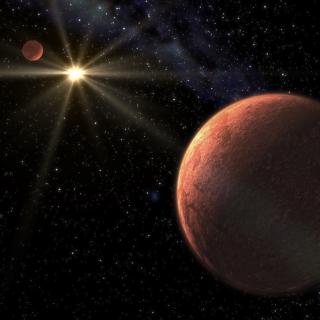Bibcode
Luque, R.; Nowak, G.; Pallé, E.; Kossakowski, D.; Trifonov, T.; Zechmeister, M.; Béjar, V. J. S.; Cardona Guillé, C.; Tal-Or, L.; Hidalgo, D.; Ribas, I.; Reiners, A.; Caballero, J. A.; Amado, P. J.; Quirrenbach, A.; Aceituno, J.; Cortés-Contreras, M.; Díez-Alonso, E.; Dreizler, S.; Guenther, E. W.; Henning, T.; Jeffers, S. V.; Kaminski, A.; Kürster, M.; Lafarga, M.; Montes, D.; Morales, J. C.; Passegger, V. M.; Schmitt, J. H. M. M.; Schweitzer, A.
Bibliographical reference
Astronomy and Astrophysics, Volume 620, id.A171, 12 pp.
Advertised on:
12
2018
Journal
Citations
36
Refereed citations
34
Description
We announce the discovery of two planetary companions orbiting around
the low-mass stars Ross 1020 (GJ 3779, M4.0V) and LP 819-052 (GJ 1265,
M4.5V). The discovery is based on the analysis of CARMENES radial
velocity (RV) observations in the visual channel as part of its survey
for exoplanets around M dwarfs. In the case of GJ 1265, CARMENES
observations were complemented with publicly available Doppler
measurements from HARPS. The datasets reveal two planetary companions,
one for each star, that share very similar properties: minimum masses of
8.0 ± 0.5 M⊕ and 7.4 ± 0.5
M⊕ in low-eccentricity orbits with periods of 3.023
± 0.001 d and 3.651 ± 0.001 d for GJ 3779 b and GJ 1265 b,
respectively. The periodic signals around 3 d found in the RV data have
no counterpart in any spectral activity indicator. Furthermore, we
collected available photometric data for the two host stars, which
confirm that the additional Doppler variations found at periods of
approximately 95 d can be attributed to the rotation of the stars. The
addition of these planets to a mass-period diagram of known planets
around M dwarfs suggests a bimodal distribution with a lack of
short-period low-mass planets in the range of 2-5 M⊕.
It also indicates that super-Earths (>5 M⊕)
currently detected by RV and transit techniques around M stars are
usually found in systems dominated by a single planet.
The RV and formal uncertainties of GJ 3779 and GJ 1265 are only
available at the CDS via anonymous ftp to http://cdsarc.u-strasbg.fr
(ftp://130.79.128.5) or via http://cdsarc.u-strasbg.fr/viz-bin/qcat?J/A+A/620/A171
Related projects

Very Low Mass Stars, Brown Dwarfs and Planets
Our goal is to study the processes that lead to the formation of low mass stars, brown dwarfs and planets and to characterize the physical properties of these objects in various evolutionary stages. Low mass stars and brown dwarfs are likely the most numerous type of objects in our Galaxy but due to their low intrinsic luminosity they are not so
Rafael
Rebolo López

Exoplanets and Astrobiology
The search for life in the universe has been driven by recent discoveries of planets around other stars (known as exoplanets), becoming one of the most active fields in modern astrophysics. The growing number of new exoplanets discovered in recent years and the recent advance on the study of their atmospheres are not only providing new valuable
Enric
Pallé Bago